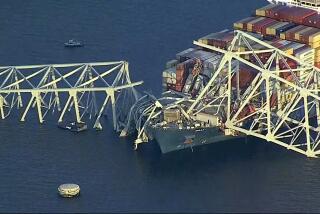Luxembourg Alarmed by Suicides
- Share via
LUXEMBOURG, Belgium — People living under Luxembourg’s highest bridge live in constant fear of being hit by a falling body.
“They fall on our roofs. They fall in our gardens. . . . They land in the middle of the street in broad daylight,” said Clement Engelmann, secretary of the local residents’ association.
He and other residents of Pfaffenthal, an old part of town in the shadow of towering cliffs, have been complaining ever since the 250-foot-high bridge was built over the gorge to the east of the capital in 1966.
They have been peppered with beer bottles, stones and all sorts of debris.
However, the suicides are the worst problem.
From that height bodies go straight through the house roof and end up in the attic, Engelmann said.
The roofs of two of the 10 houses under the bridge have an obvious patch of new tiles. Residents cannot insure their houses against such damage.
“It’s an abnormal risk and no one will do it,” said Ernest Voss, inspector with Assurlux, one of Luxembourg’s biggest insurers.
There has not been an exact count of the number of bodies that have landed in the two streets immediately below the elegant red steel bridge. No one has survived the fall.
Newspaper reports say there were 67 in the 15 years to 1989. There were at least 10 in 1989.
Engelmann said the average is three or four a year.
Luxembourg’s suicide rate is not the highest in Europe, but recent figures from the State Statistics Office showed that it has climbed steadily since the 1950s to reach the level of the depressed early 1930s.
Jumping off high places accounts for around 20% of suicides, compared to 6% at the beginning of the century.
Luxembourg’s capital, perched on a rock cut away on three sides by rivers, boasts 93 bridges and extensive cliffs. The 1,155-foot-long “Red Bridge” is wedged into the top of the gorge cut by the Alzette River. It carries the main road to Germany and connects the capital with European Community institutions.
Engelmann said that as the bridge’s notoriety grows, it attracts more suicides and increases the danger for the 15 families directly underneath.
Strangely, people always seem to choose to jump onto the houses and not into the river or the vegetable plots along the middle of the valley.
“Perhaps it’s a fear of not being found,” Engelmann said.
Pfaffenthal residents have been sending telegrams to the minister of public works each time there is a new suicide.
No one has yet been killed by a falling body, but locals say it is bound to happen one day.
Parents also worry about the effects on children who see a suicide.
The government is at last responding to residents’ petitions and trying out preventive measures.
Four different plastic panels have been put up along the side of the bridge to see which looks best.
“We just want the highest,” Engelmann said.
More to Read
Sign up for Essential California
The most important California stories and recommendations in your inbox every morning.
You may occasionally receive promotional content from the Los Angeles Times.













